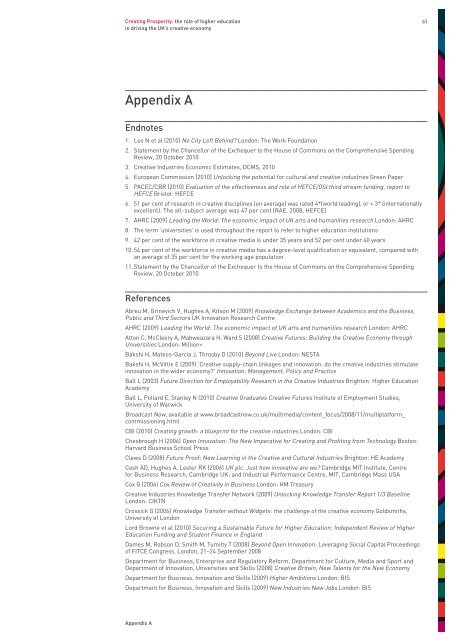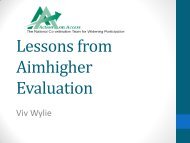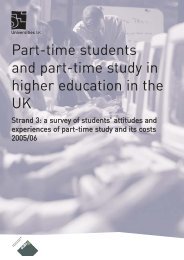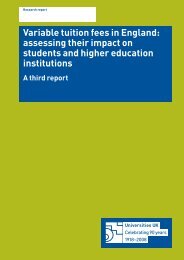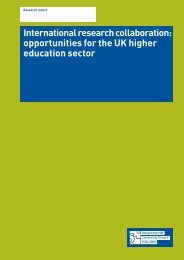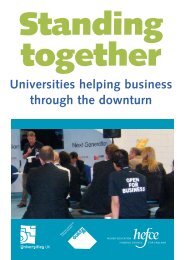Creating Prosperity: the role of higher education in ... - Universities UK
Creating Prosperity: the role of higher education in ... - Universities UK
Creating Prosperity: the role of higher education in ... - Universities UK
You also want an ePaper? Increase the reach of your titles
YUMPU automatically turns print PDFs into web optimized ePapers that Google loves.
<strong>Creat<strong>in</strong>g</strong> <strong>Prosperity</strong>: <strong>the</strong> <strong>role</strong> <strong>of</strong> <strong>higher</strong> <strong>education</strong><strong>in</strong> driv<strong>in</strong>g <strong>the</strong> <strong>UK</strong>’s creative economy61Appendix AEndnotes1. Lee N et al (2010) No City Left Beh<strong>in</strong>d? London: The Work Foundation2. Statement by <strong>the</strong> Chancellor <strong>of</strong> <strong>the</strong> Exchequer to <strong>the</strong> House <strong>of</strong> Commons on <strong>the</strong> Comprehensive Spend<strong>in</strong>gReview, 20 October 20103. Creative Industries Economic Estimates, DCMS, 20104. European Commission [2010] Unlock<strong>in</strong>g <strong>the</strong> potential for cultural and creative <strong>in</strong>dustries Green Paper5. PACEC/CBR (2010) Evaluation <strong>of</strong> <strong>the</strong> effectiveness and <strong>role</strong> <strong>of</strong> HEFCE/OSI third stream fund<strong>in</strong>g, report toHEFCE Bristol: HEFCE6. 51 per cent <strong>of</strong> research <strong>in</strong> creative discipl<strong>in</strong>es (on average) was rated 4*(world lead<strong>in</strong>g), or + 3* (<strong>in</strong>ternationallyexcellent). The all-subject average was 47 per cent (RAE, 2008, HEFCE)7. AHRC [2009] Lead<strong>in</strong>g <strong>the</strong> World: The economic impact <strong>of</strong> <strong>UK</strong> arts and humanities research London: AHRC8. The term ‘universities’ is used throughout <strong>the</strong> report to refer to <strong>higher</strong> <strong>education</strong> <strong>in</strong>stitutions9. 42 per cent <strong>of</strong> <strong>the</strong> workforce <strong>in</strong> creative media is under 35 years and 52 per cent under 40 years10. 54 per cent <strong>of</strong> <strong>the</strong> workforce <strong>in</strong> creative media has a degree-level qualification or equivalent, compared withan average <strong>of</strong> 35 per cent for <strong>the</strong> work<strong>in</strong>g age population11. Statement by <strong>the</strong> Chancellor <strong>of</strong> <strong>the</strong> Exchequer to <strong>the</strong> House <strong>of</strong> Commons on <strong>the</strong> Comprehensive Spend<strong>in</strong>gReview, 20 October 2010ReferencesAbreu M, Gr<strong>in</strong>evich V, Hughes A, Kitson M (2009) Knowledge Exchange between Academics and <strong>the</strong> Bus<strong>in</strong>ess,Public and Third Sectors <strong>UK</strong> Innovation Research CentreAHRC (2009) Lead<strong>in</strong>g <strong>the</strong> World: The economic impact <strong>of</strong> <strong>UK</strong> arts and humanities research London: AHRCAtton C, McCleery A, Mabweazara H, Ward S (2008) Creative Futures: Build<strong>in</strong>g <strong>the</strong> Creative Economy through<strong>Universities</strong> London: Million+Bakshi H, Mateos-Garcia J, Throsby D (2010) Beyond Live London: NESTABakshi H, McVittie E (2009) ‘Creative supply-cha<strong>in</strong> l<strong>in</strong>kages and <strong>in</strong>novation: do <strong>the</strong> creative <strong>in</strong>dustries stimulate<strong>in</strong>novation <strong>in</strong> <strong>the</strong> wider economy?’ Innovation: Management, Policy and PracticeBall L (2003) Future Direction for Employability Research <strong>in</strong> <strong>the</strong> Creative Industries Brighton: Higher EducationAcademyBall L, Pollard E, Stanley N (2010) Creative Graduates Creative Futures Institute <strong>of</strong> Employment Studies,University <strong>of</strong> WarwickBroadcast Now, available at www.broadcastnow.co.uk/multimedia/content_focus/2008/11/multiplatform_commission<strong>in</strong>g.htmlCBI (2010) <strong>Creat<strong>in</strong>g</strong> growth: a bluepr<strong>in</strong>t for <strong>the</strong> creative <strong>in</strong>dustries London: CBIChesbrough H (2006) Open Innovation: The New Imperative for <strong>Creat<strong>in</strong>g</strong> and Pr<strong>of</strong>it<strong>in</strong>g from Technology Boston:Harvard Bus<strong>in</strong>ess School PressClews D (2008) Future Pro<strong>of</strong>: New Learn<strong>in</strong>g <strong>in</strong> <strong>the</strong> Creative and Cultural Industries Brighton: HE AcademyCosh AD, Hughes A, Lester RK (2006) <strong>UK</strong> plc: Just how <strong>in</strong>novative are we? Cambridge MIT Institute, Centrefor Bus<strong>in</strong>ess Research, Cambridge <strong>UK</strong>; and Industrial Performance Centre, MIT, Cambridge Mass USACox G (2006) Cox Review <strong>of</strong> Creativity <strong>in</strong> Bus<strong>in</strong>ess London: HM TreasuryCreative Industries Knowledge Transfer Network (2009) Unlock<strong>in</strong>g Knowledge Transfer Report 1/3 Basel<strong>in</strong>eLondon: CIKTNCrossick G (2006) Knowledge Transfer without Widgets: <strong>the</strong> challenge <strong>of</strong> <strong>the</strong> creative economy Goldsmiths,University <strong>of</strong> LondonLord Browne et al (2010) Secur<strong>in</strong>g a Susta<strong>in</strong>able Future for Higher Education: Independent Review <strong>of</strong> HigherEducation Fund<strong>in</strong>g and Student F<strong>in</strong>ance <strong>in</strong> EnglandDames M, Robson D, Smith M, Tumilty T (2008) Beyond Open Innovation: Leverag<strong>in</strong>g Social Capital Proceed<strong>in</strong>gs<strong>of</strong> FITCE Congress, London, 21–24 September 2008Department for Bus<strong>in</strong>ess, Enterprise and Regulatory Reform, Department for Culture, Media and Sport andDepartment <strong>of</strong> Innovation, <strong>Universities</strong> and Skills (2008) Creative Brita<strong>in</strong>, New Talents for <strong>the</strong> New EconomyDepartment for Bus<strong>in</strong>ess, Innovation and Skills (2009) Higher Ambitions London: BISDepartment for Bus<strong>in</strong>ess, Innovation and Skills (2009) New Industries New Jobs London: BISAppendix A


